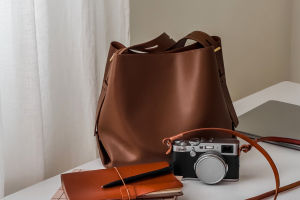Smart Casual Sorted All Year

There's nothing more frustrating than a dress code that says "smart casual." Do you wear a blazer or not? Are sneakers acceptable? What if it's 90°F in summer or freezing cold in winter?
If you've ever stood in front of your wardrobe, paralyzed by what "smart casual" really means, this guide is for you.
We're going to break down exactly how to master this flexible dress code—what works, what doesn't, and how to make seasonal adjustments without sacrificing style or comfort.
What "Smart Casual" Actually Means
Let's clear the air first. Smart casual is not just "dressing nicely." It's a mix of relaxed and refined pieces—more polished than everyday casual, but less formal than business attire.
Think: tailored trousers + sneakers, or a crisp white shirt + dark jeans.
You're combining structured pieces with something relaxed. But the key is balance—you don't want to look like you forgot it was a formal dinner, nor like you just came from a board meeting.
1. The Non-Negotiables of Smart Casual
No matter the season, there are a few wardrobe pieces that anchor any smart casual outfit:
1. Tailored Blazer (Unstructured Preferred):
A slim-fit blazer in navy, gray, or taupe adds instant polish. In summer, go for linen or cotton. In winter, opt for wool or tweed.
2. Button-Down Shirts & Knit Polos:
White, light blue, or even a subtle stripe or print can add interest. Keep it wrinkle-free and well-fitted.
3. Neutral Chinos or Tailored Trousers:
Skip the jeans if you're unsure. Slim chinos in beige, olive, or charcoal go with everything.
4. Crisp Sneakers or Loafers:
Clean, minimal sneakers (preferably leather) are fair game. Loafers or desert boots work better in colder months.
5. Good Outerwear:
Smart casual doesn't end with your coat. Think trench coat in spring, wool overcoat in winter.

2. Summer Smart Casual: Light, Not Lazy
Summer brings a challenge: staying cool without looking too casual. Here's how to beat the heat without resorting to flip-flops or shorts.
Keep these 3 tips in mind:
• Go for breathable fabrics: Linen shirts, cotton pants, and unlined blazers are your best friends. Avoid polyester and anything that clings.
• Layer lightly: Try a polo under a linen blazer or a short-sleeve button-up with rolled chinos.
• Use color wisely: Light neutrals like sand, stone, or sky blue reflect heat and keep your look fresh.
Example combo: White linen button-up + beige chinos + brown loafers + canvas tote. Effortless and smart.
3. Winter Smart Casual: Stay Warm, Stay Sharp
Cold weather doesn't mean giving up on smart dressing. It's all about layering wisely.
Here's how to do it right:
• Layer with intention: Start with a shirt, add a fine merino sweater, and top it with a tailored coat. Avoid bulk by keeping the layers thin but warm.
• Choose winter textures: Wool blazers, corduroy trousers, and leather boots elevate the look and provide warmth.
• Accessorize smartly: Scarves, gloves, and beanies can be functional and fashionable—just keep the colors neutral or match them to your coat.
Example combo: Grey wool blazer + navy turtleneck + dark chinos + leather Chelsea boots.
4. From Office to Off-Duty—Seamlessly
The beauty of smart casual is how easily it can adapt to different parts of your day.
Try these easy switches:
• Blazer off, knit on: After work, ditch the blazer and throw on a half-zip sweater or casual bomber.
• Change the shoes: Swap loafers for sneakers if you're heading to a casual dinner or drinks.
• Backpack vs. Briefcase: A leather backpack feels more relaxed than a formal briefcase, but still professional.
This versatility is what makes smart casual such a valuable style—it bends without breaking the rules.
5. A Few Don'ts to Keep You Grounded
1. Don't wear gym sneakers. Stick to clean, minimal styles.
2. Don't confuse casual with sloppy. Iron your shirt. Clean your shoes.
3. Don't go too formal. A three-piece suit is not smart casual. Neither is a tie.
4. Don't ignore fit. No matter the outfit, bad fit ruins everything.
Final Thought: Smart Casual Is Personal
Here's the truth: There's no one smart casual uniform. It's meant to be flexible, and your personality should shine through.
Instead of worrying if you've "got it right," focus on combining comfort and structure. Use seasonal textures, colors, and layers to adjust your base outfit, and don't underestimate the power of accessories—watches, belts, and bags make a difference.
Ever been to an event and felt either overdressed or underdressed thanks to the "smart casual" label? What did you end up wearing—and did it work? Let's swap outfit wins and disasters—I'd love to hear what worked (or didn't) for you.
-
 Leather Losing Its Shine?Say Goodbye To Stains And Cracks! The Perfect Routine For Leather Bag Care Revealed!
Leather Losing Its Shine?Say Goodbye To Stains And Cracks! The Perfect Routine For Leather Bag Care Revealed! -
 Avoid These ErrorsTop 10 Skincare Mistakes to Avoid: Are You Sabotaging Your Skin Without Realizing It?
Avoid These ErrorsTop 10 Skincare Mistakes to Avoid: Are You Sabotaging Your Skin Without Realizing It? -
 Camera-Ready StyleWhy your neckline, sleeves, and earrings matter more than your pants when WFH!
Camera-Ready StyleWhy your neckline, sleeves, and earrings matter more than your pants when WFH!